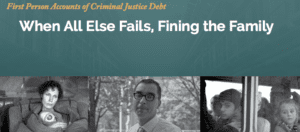Q&A About ‘When All Else Fails, Fining the Family,’ a New Paper from the Center for Community Alternatives
 A recent paper from the Center for Community Alternatives (CCA), in collaboration with researchers from the City of Newark, New Jersey, and Cornell University, explores the impacts of the frequently crippling financial obligations facing individuals reentering the community from jail or prison. The paper, “When All Else Fails, Fining the Family: First Person Accounts of Criminal Justice Debt,” features real stories from formerly incarcerated individuals and their families who face considerable sums of criminal justice debt from court fines, fees, victim restitution, and child support.
A recent paper from the Center for Community Alternatives (CCA), in collaboration with researchers from the City of Newark, New Jersey, and Cornell University, explores the impacts of the frequently crippling financial obligations facing individuals reentering the community from jail or prison. The paper, “When All Else Fails, Fining the Family: First Person Accounts of Criminal Justice Debt,” features real stories from formerly incarcerated individuals and their families who face considerable sums of criminal justice debt from court fines, fees, victim restitution, and child support.
Through research and interviews, the authors found that the types of financial obligations owed by the previously incarcerated have proliferated in recent years. Most of those interviewed reported being unaware of how much debt was accruing during incarceration. Typical debt enforcement methods include wage garnishments, extended supervision, driver’s license suspension, additional fines, and even a return to incarceration. This cycle of debt and punishments often leaves individuals feeling their crimes are never behind them, and that they cannot successfully reenter society.
Faced with mounting debt obligations, as well as other barriers to reentry such as difficulty finding stable employment, housing, and transportation, many formerly incarcerated individuals end up turning to their family members for help—family members who are often already living at the edge of extreme poverty. The outsized impact of these debts can foster a cycle of criminal involvement. According to the U.S. Office of Child Support Enforcement, such a large amount of debt “increases the likelihood that noncustodial parents released from incarceration will enter the underground economy.”
The authors of the report suggest five policies that might alleviate these debt burdens:
- Automatically suspend child support obligations during incarceration for individuals who cannot pay. Utilize driver’s license forfeiture as a last resort only when there is “willful failure to pay.”
- Provide transparency in criminal justice debt. States should develop an inventory of financial penalties and consolidate them into one moderate fee.
- Base all criminal justice sanctions on ability to pay, and eliminate supervision fees altogether. Judges should have the discretion to waive fees for individuals who have considerable financial hardship.
- Adopt a moratorium on the enactment of additional criminal justice debt obligations until these recommendations are adopted.
- No new laws for criminal justice debt should be adopted without conducting a “reentry impact” statement. This would require legislatures to review existing financial penalties before proposing new ones or enhancing existing ones.
To learn more about criminal justice debt and its family-level impacts, the Council of State Governments Justice Center (CSGJC) talked to Patricia Warth, Director of Justice Strategies at CCA , and Mary Fainsod Katzenstein, the Stephen and Evalyn Milman Professor of American Studies at Cornell University, who, along with Mitali Nagrecha of the City of Newark Office of Reentry, authored “When All Else Fails, Fining the Family.”
CSGJC: How did you and your organization originally become interested in the topic of criminal justice debt? And how have people responded to your paper?
Patricia Warth: CCA’s direct service work prompted our interest in the issue of criminal justice debt. Our preliminary investigation revealed that debt can be found everywhere. Yet no one had aggregated this debt, so no one could say with any degree of confidence what the total financial costs of a criminal conviction might be. In 2004, CCA’s Alan Rosenthal was invited to serve as member of the New York State Bar Association’s Special Committee on Collateral Consequences of Criminal Proceedings, which produced a final report stating that when “such financial penalties are totaled, their sum is at times staggering.” This led to CCA’s 2007 report Sentencing for Dollars: The Financial Consequences of a Criminal Conviction. That report illuminates the vast array of statutorily authorized criminal justice debt that, once aggregated, shows just how staggering it can be and how this debt poses significant barriers to people living law-abiding, dignified lives in the community.
“When All Else Fails” explains how this debt impacts not just individuals, but also families and entire communities. We believe that these papers have contributed to the emerging public awareness that criminal justice debt is yet another means by which our “tough on crime” policies have further marginalized individuals and communities. Because the criminal justice system disproportionately impacts communities of color, the imposition of this debt has unfairly impacted communities of color. This means that the issue of criminal justice debt is also a civil rights issue.
CSGJC: Some of the policy recommendations in the paper seem like they could face considerable political opposition. Critics might paint them as being “soft on crime.” How do you frame these recommendations to overcome potential critics?
PW: Current public discourse provides two significant opportunities for framing the recommendations. The first is the bipartisan support in favor of criminal justice reform, as seen during the March 26, 2015, Bipartisan Summit on Criminal Justice Reform. A growing number of politicians and policymakers are identifying tough-on-crime policies as ill-conceived and counterproductive and instead advocating for policies that are “smart on crime.” This paper reveals that it is not smart on crime to impose criminal justice debt that creates insurmountable barriers to employment, housing, family reunification, and educational opportunities and burdens families and communities already marginalized by poverty.
The second opportunity is the U.S. Department of Justice’s recent report on criminal justice policies and practices in Ferguson, Missouri. DOJ concluded that Ferguson’s criminal justice policies are not driven by public safety concerns, but instead by a desire to generate revenue. According to that report, this focus on revenue enhancement and the resulting practices “both reflect and exacerbate existing racial bias, including racial stereotypes.” In stark terms, the DOJ report highlights the reality that shifting the costs of our criminal justice system onto those who cannot pay exacerbates the racial and socioeconomic divide in our county.
CSGJC: What would basing financial penalties on “ability to pay” look like? Are there examples of this in practice?
PW: Imposing criminal justice financial penalties on an ability-to-pay basis is not new. For years, judges and other decision-makers exercised discretion in assessing financial penalties. Our tough-on-crime policies eliminated much of this discretion, often rendering criminal justice debt mandatory. Our ability-to-pay recommendation is simple: restore to judges and other decision-makers the discretion in imposing financial penalties. This allows judges to decide whether a financial penalty is needlessly punitive.
The ability-to-pay model forces us to be clear about the purpose and goals of criminal justice financial penalties. It requires decision-makers to ask: Can this person really pay? Who will bear the burden, the individual or the family? How will imposition of this financial penalty impact the person’s ability to live a law-abiding, successful life in the community? If the financial penalty creates a barrier to opportunities needed to live a law-abiding life, it punishes all of us.
CSGJC: When it comes to the paper’s format, why did you use personal narratives instead of another method to tell this story?
Mary Fainsod Katzenstein: Asking people about money, especially financial dependency, involves sensitive matters and often very complex arrangements. Talking to people individually allows give-and-take that a survey analysis would not. Also, personal narratives bring home the importance of an insight. When one individual detailed the long roster of money he owed and the penalties associated with the obligations and exclaimed, “Punishment is everywhere!” it brought home to us the depth of his reality.
Dependence on friends and family is also very complicated. First-person narratives gave us a sense of the myriad financial obligations for which individuals turn to families and friends.
CSGJC: What does the future of this project look like, and how do you carry the work on this topic forward?
MFK: One important future step is to identify policies that base financial obligations on ability to pay. The Office of Child Support Enforcement and other federal government entities have taken important measures to ensure such realistic enforcement. Other examples include the Massachusetts court order that money collected from those in jail on a pay-to-stay basis, much of it paid by inmates’ families, be returned. There are a number of public policy responses sensitive to ability to pay that avoid the inexcusable burden on families who have not themselves, in any way, violated the law.
PW: This paper is an important addition to other work on criminal justice debt, including work done by CCA, the Brennan Center, and more recently, NPR’s Joe Shapiro. It is an important contribution because it illuminates that this issue does not just impact individuals, but also families and communities. As Mary recognizes, all of this ongoing work constitutes an important tool for reentry and criminal justice reform. Advocates can use it to convince policymakers to roll back four decades of tough-on-crime polices that created more debt while simultaneously taking discretion away from decision-makers. We are sharing this paper with advocates and community members. We believe that the best way to convince the public of the importance of this issue is to put a human face on it.
Additional information:
- Read the full paper: “When All Else Fails, Fining the Family”
- CCA’s working paper on criminal justice debt: “Sentencing for Dollars: the Financial Consequences of a Criminal Conviction”
- Report of the New York State Bar Association’s Special Committee on Collateral Consequences of Criminal Proceedings: Reentry and Reintegration: The Road to Public Safety
- Council of State Governments Justice Center’s resources on Legal Financial Obligations
- Report on the U.S. Department of Justice Investigation of the Ferguson Police Department
- Fact sheet from the U.S. Department of Health and Human Services, Office of Child Support Enforcement: “Establishing Realistic Child Support Orders”
- NPR News Investigations series by Joe Shapiro: “Guilty and Charged”
 Zero Returns to Homelessness Initiative Launches Nationally, with Pennsylvania Leading the Way
Read More
Zero Returns to Homelessness Initiative Launches Nationally, with Pennsylvania Leading the Way
Read More
 New Hampshire Continues Justice Reinvestment Effort to Improve Conditions for People Who Are High Utilizers of Criminal Justice and Behavioral Health Systems
Read More
New Hampshire Continues Justice Reinvestment Effort to Improve Conditions for People Who Are High Utilizers of Criminal Justice and Behavioral Health Systems
Read More














